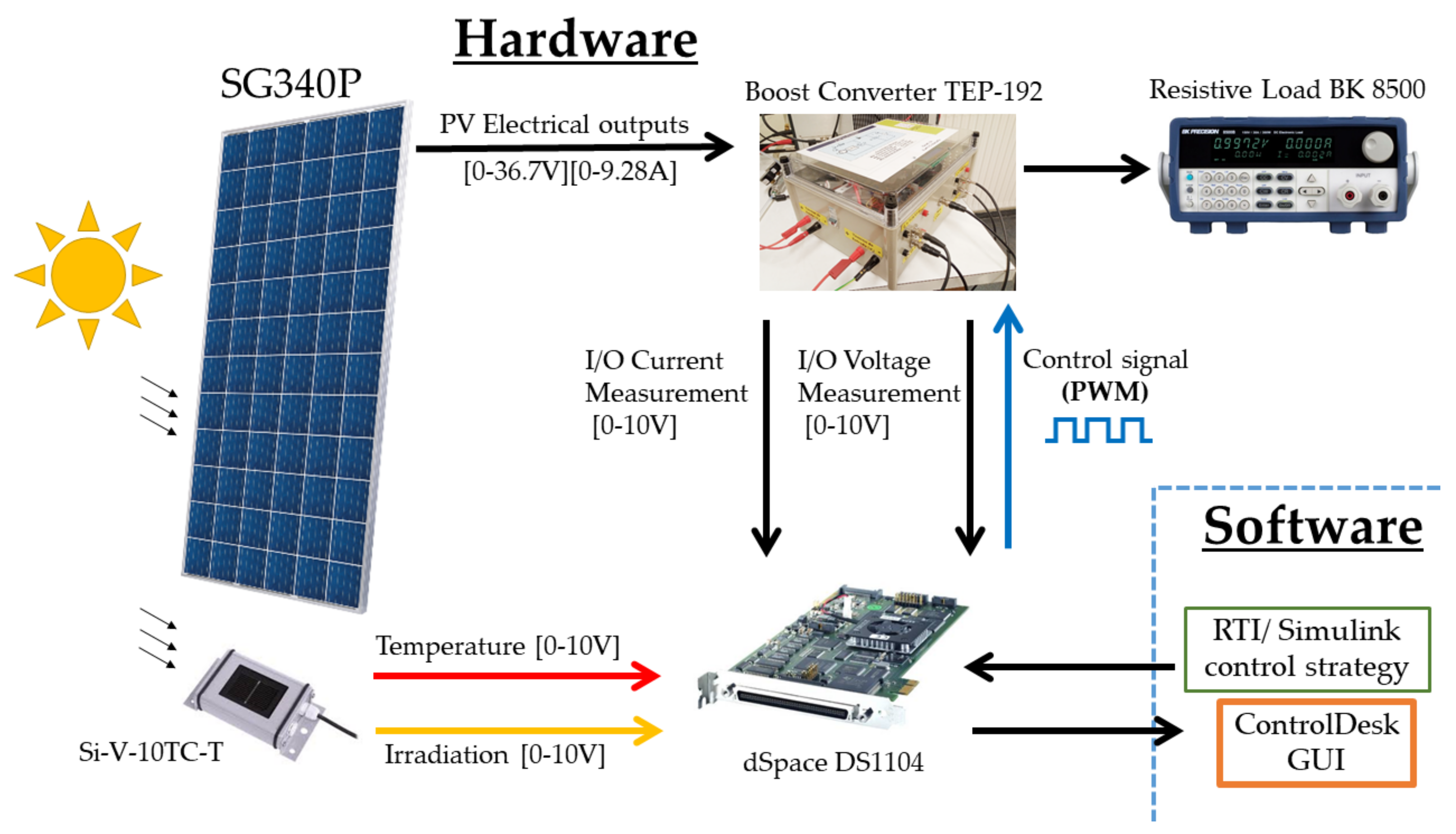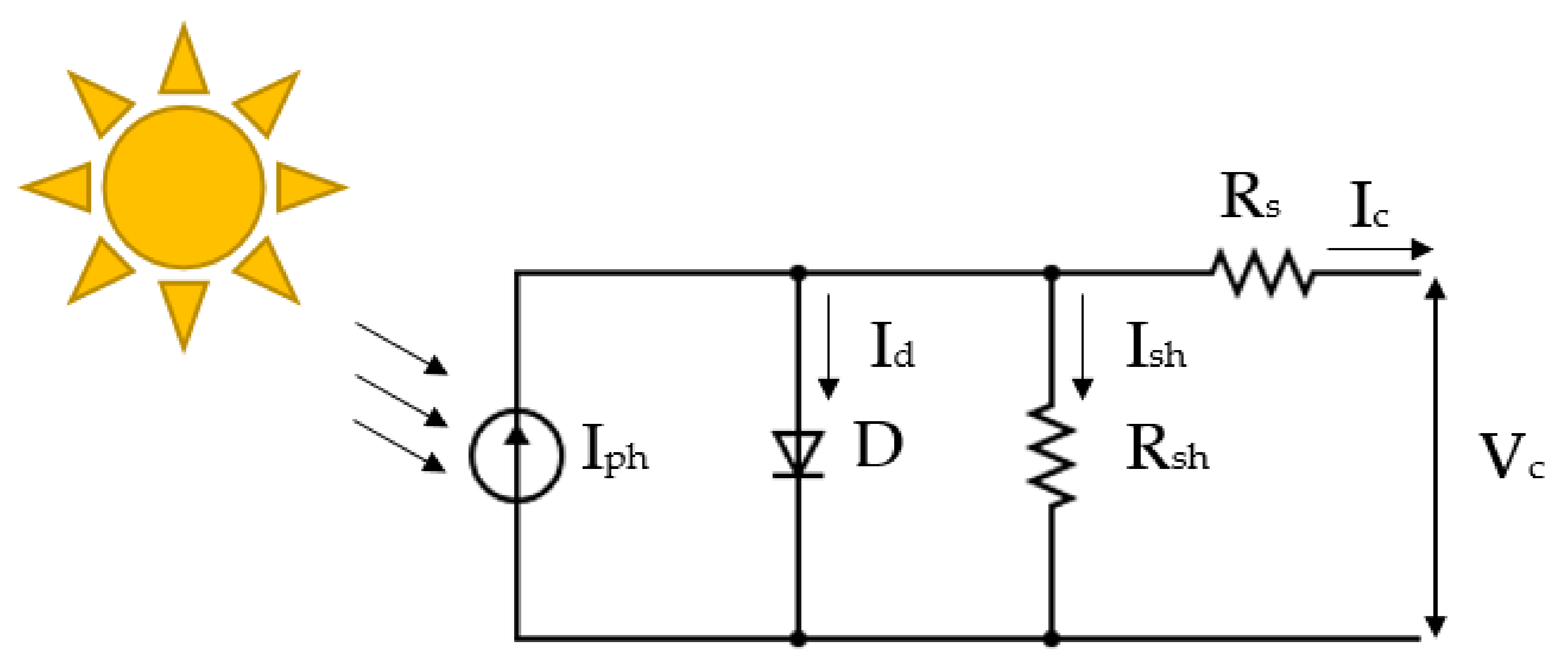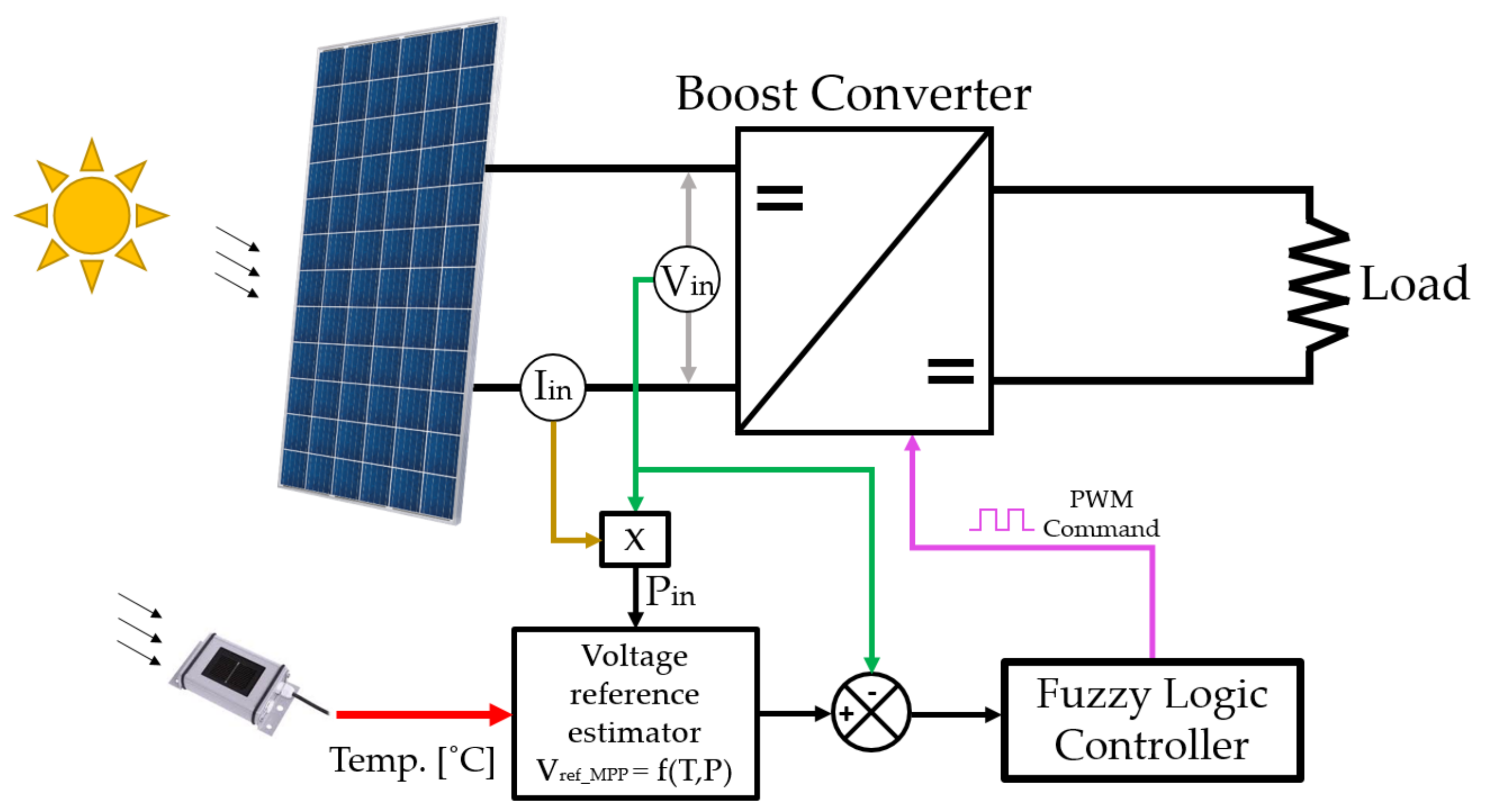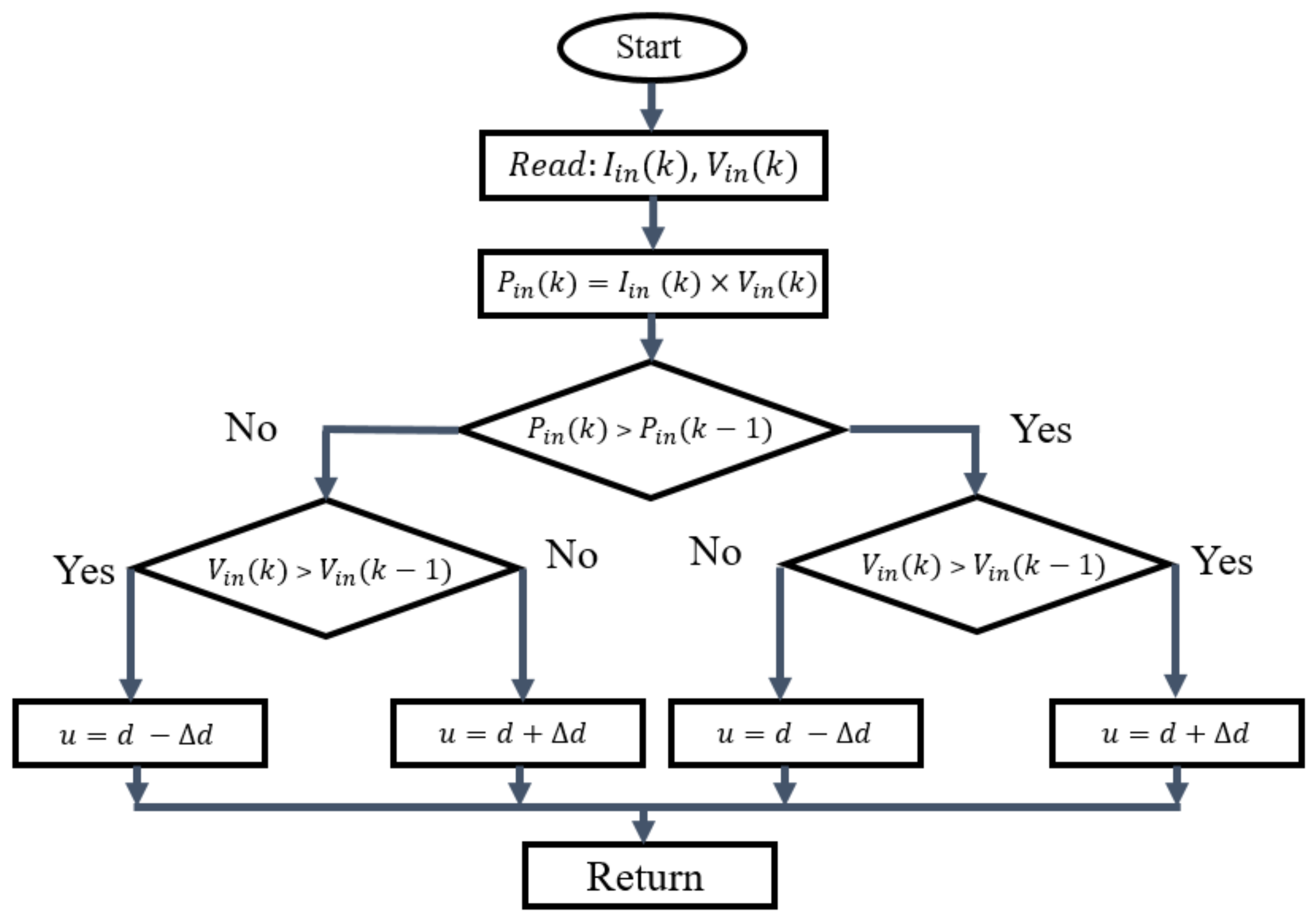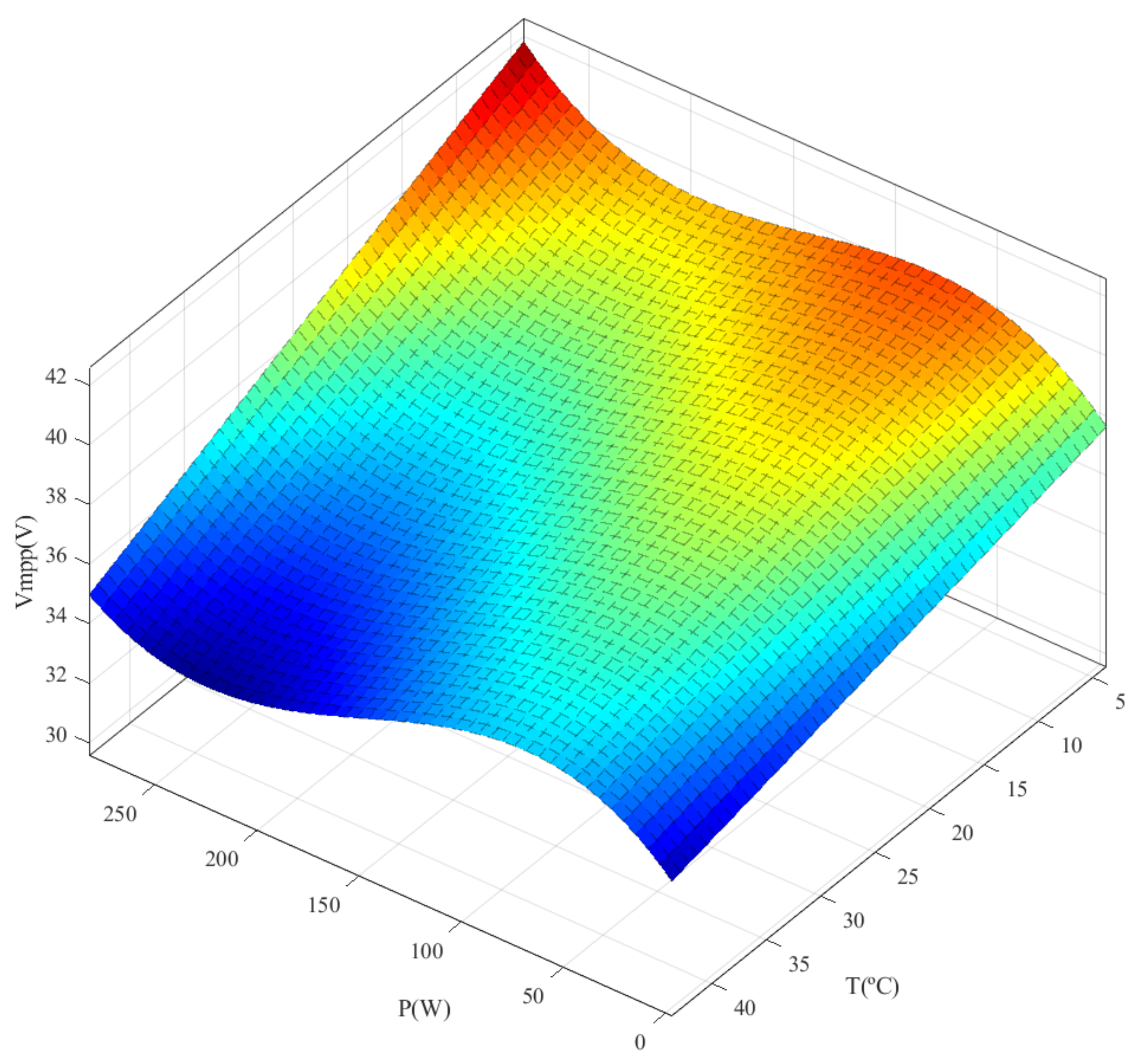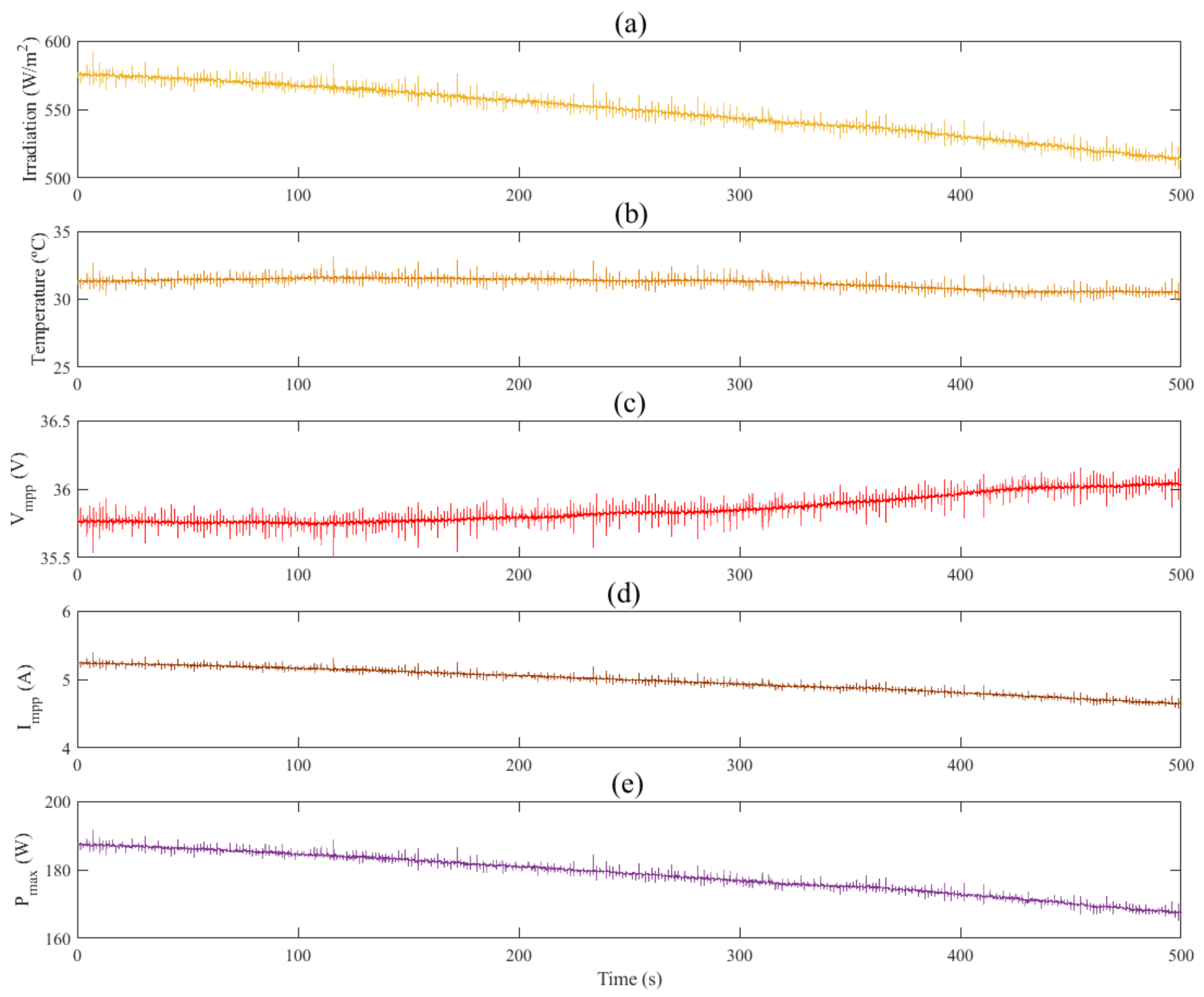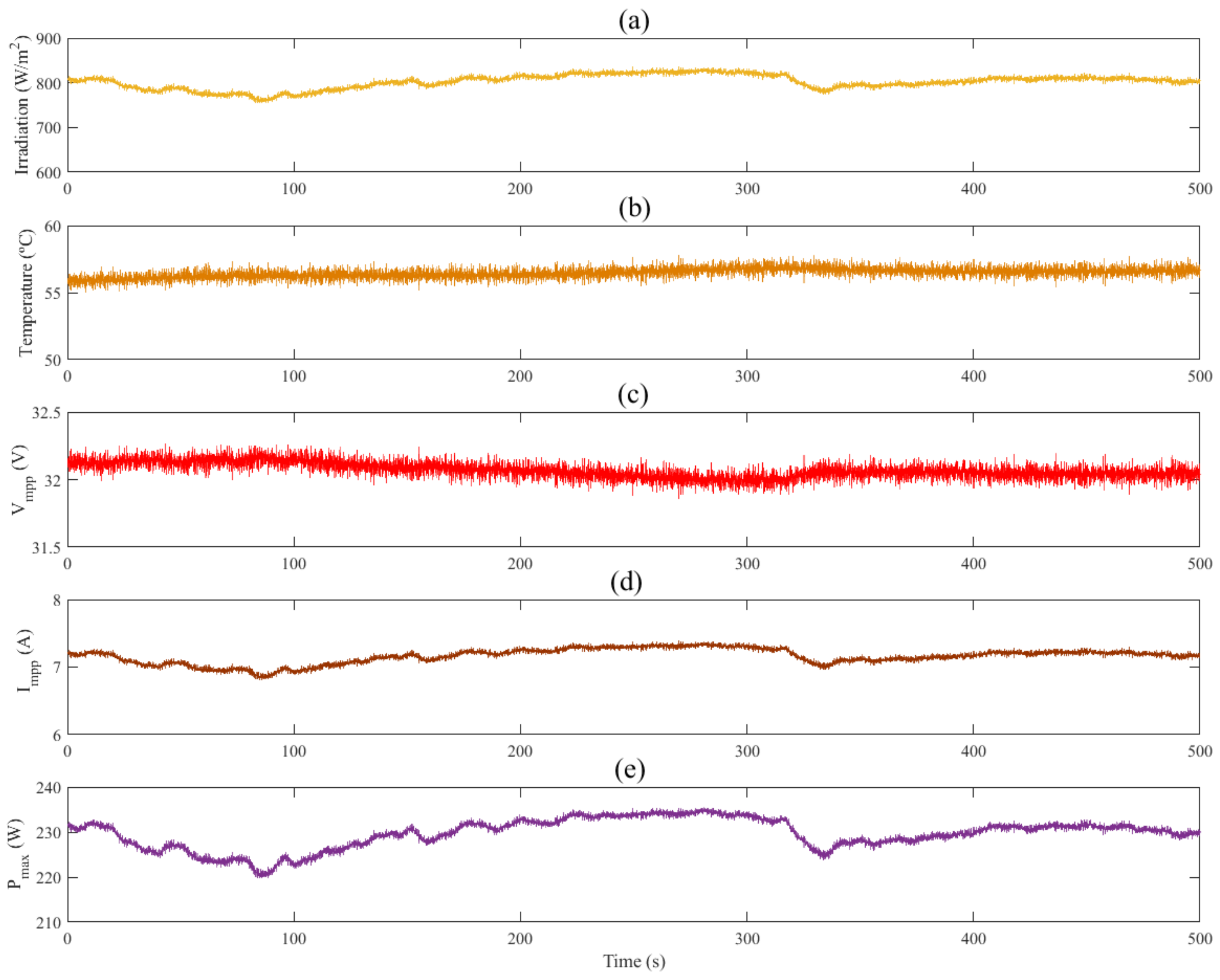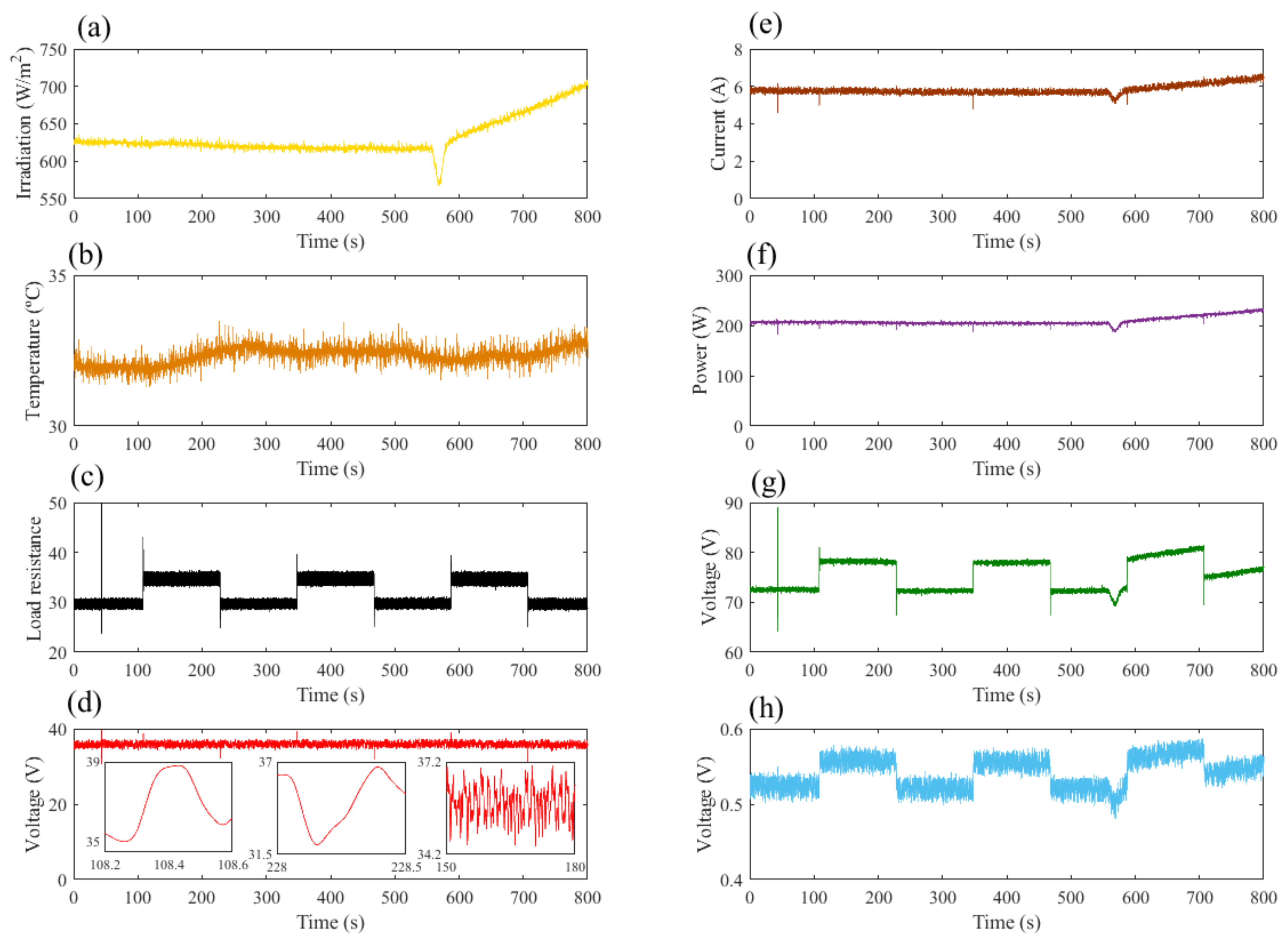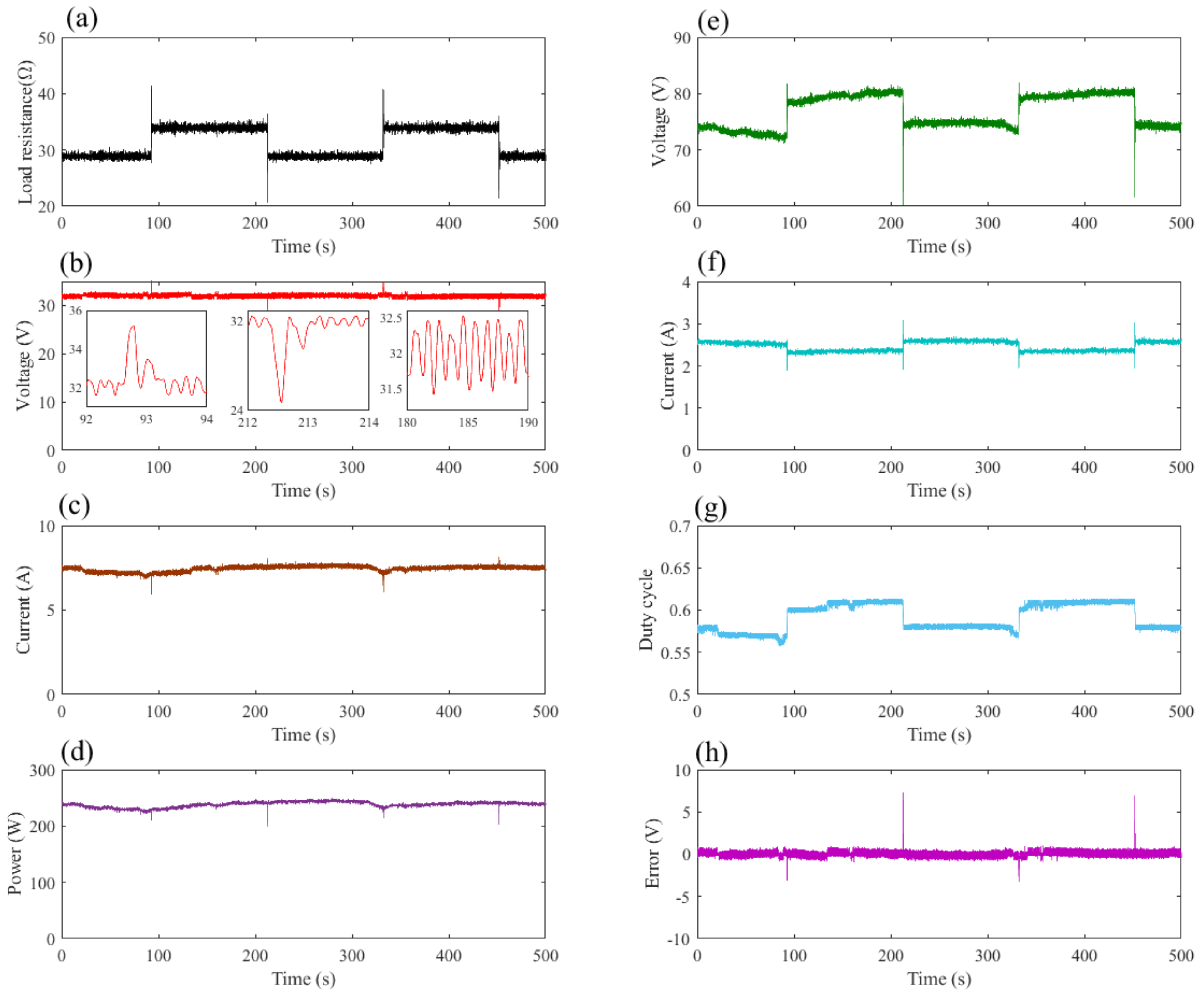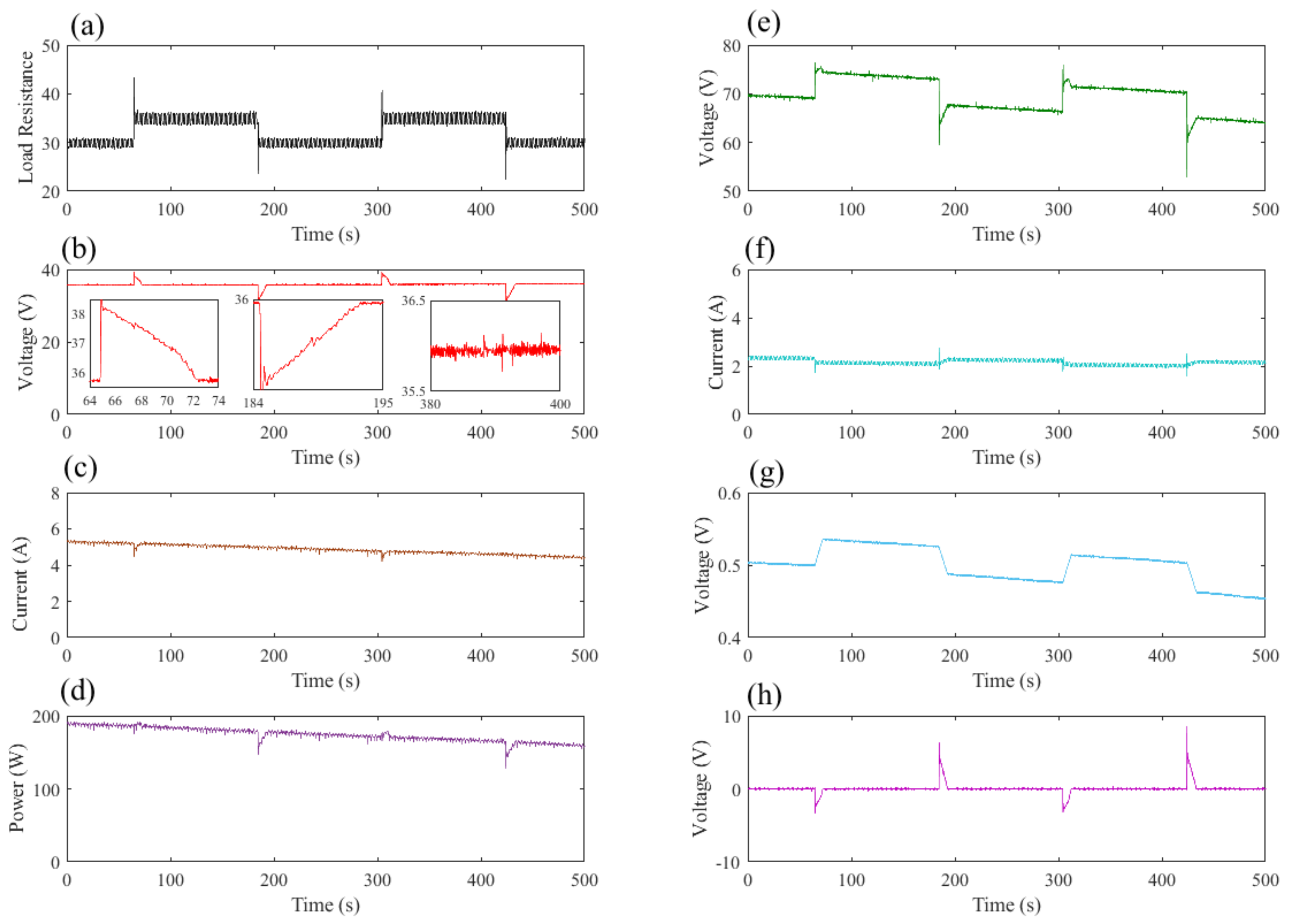1. Introduction
The increasing degree of pollution throughout the last decades made a change of direction in the policies of energy production, where renewables are preferred over the conventional ones. Actually, it an increment of 25% in the world energy consumption is expected for 2040, and the target is that clean ones can provide 40% of the whole production [
1]. Researchers also forecast that solar PV panels could generate 15% of the global demand in 2050 [
2].
Despite PV panels being highly dependent on sun irradiation (which fluctuates sufficiently depending on the geographical location), major advantages include the low maintenance and a large life-span service [
3]. In several applications where a PV output voltage is unsuitable, DC–DC boost converters are used to step-up this variable, thus increasing the efficiency of the whole system. The voltage growth is carried out through a switching of electric circuits which indicates that the end-user voltage is dependent on a duty cycle [
4]. The switching signal can be managed by a pulse-width-modulation (PWM) generator; this implies that a suitable control law can be designed with the target of maximizing the performance of the MPPT.
Linear strategies can be a suitable first option for MPPT control. Despite the conventionality of proportional–integral–derivative (PID) controllers, they have been widely used in PV power systems. For instance, the author of [
5] produced a linear simulation of a DC–DC converter with a PV panel; despite the controller being achieved through classic Bode analysis, the results reported a reduction of overshoot and settling time. Likewise, an advanced linear quadratic regulator (LQR) has been developed for boost-converters [
6]; although the measurement of the performance of this algorithm needs experimental validation, the simulation outcomes revealed increments in robustness in comparison with similar strategies. However, linear controllers produce certain issues for real boost converters due to inconsistencies such as the intrinsic non-minimum phase [
7]. Additionally, there are nonlinearities, such as solar energy, that depend on everyday weather; panels have assorted voltage-current oscillations and boost converters have a discontinuous action due to the switching [
8,
9].
Nonlinear controllers are known not only for the performance improvement of boost converters but also for their practical implementation [
10]. The P&O algorithm is a reliable nonlinear algorithm for MPPT that compares previous power measurements to current ones to find the MPP, using the duty cycle as a variable [
11]. In the field of PV panels, this algorithm has even been studied in advanced and complex systems, such as PVs in space applications, as the authors of [
12] explained in their research. The combination of this algorithm with a solar tracker provided suitable results. Due to its properties, it has also been used in assorted renewable systems such as wave energy generators [
13], PV based microgrids [
14], wind generators [
15], and so forth. Despite its robustness and practicality, the downsides of P&O are related to the generated perturbations or partial shadow cases, which can produce, respectively, oscillations around the MPP or fall to a local maximum, which produces a reduction in accuracy [
16,
17].
Another classic nonlinear structure is SMC, which not only enhances the dynamics of a system but also reduces the effects of disturbances and uncertainties [
18]. For instance, Derbeli et al. [
19] proposed SMC for a boost-converter used in a fuel cell. The outcomes showed that one of the primary disadvantages of these structures is the chattering, which causes extra energy consumption. Even though the chattering can be reduced by using high order sliding modes—which have been implemented in the past [
20]—it is impossible to eliminate this phenomenon since there are always unmodeled dynamics involved with control digitalization [
21]. Backstepping depicts another nonlinear structure, known for its robustness in terms of unmodeled dynamics and uncertainties, based on a Lyapunov approach by splitting the main system into subdivisions to achieve a suitable design [
22]. In practical terms, backstepping has been implemented in a boost converter by the authors of [
23], where the robustness and settling time have been improved; nevertheless, one of the main drawbacks of the backstepping is the complex design of the control law.
Another non-linear technique is FLC, a practical, ruled-based approach in which the configuration is dependent on the operator knowledge with regards to the main system [
24,
25]. FLC has been used in adaptive experimental DC–DC boost converters, where the inductor features changed to achieve high efficiencies and the outcomes showed significant enhancements [
26]. In terms of PV, the research conducted by the authors of [
27] was based on an analysis of the power forecast over a year, where they employed an adaptive neural fuzzy inference system and accurate results were achieved. Concerning MPPT for PV systems linked with boost converters, FLC was used by the authors of [
28], where they showed that the outcomes developed a fast dynamic response and ensured the robustness. FLC has also been embedded for a PV battery system in a study based on an optimisation [
29]; in this case, the state of charge and consumption were studied and the results revealed significant improvements.
This research is focused on a type-1 FLC, which is known for its higher performance compared to conventional controllers due to its capability to manage uncertainties through rules [
30,
31]. A VRE was designed with real data from the PV panel and was assembled with a type-1 FLC, an error-based controller used for tracking. The first comparison was performed against a P&O, as it is commonly used for the comparison of new MPPT controllers [
32,
33]. The second contrast was executed with an SMC combined with the VRE to highlight the benefits of the proposed FLC. The drawbacks are related to sudden fluctuations around the maximum power point (MPP) due to sudden fluctuations in the irradiation or under partial shadowing conditions [
33,
34].
This research paper is structured as follows:
Section 2 describes the hardware used and its interconnection, and presents a theoretical explanation of the models applied for the PV and the boost converter with further details about the controllers handled for the MPPT tracking.
Section 3 presents an experimental analysis of the PV features such as voltage–current and voltage–power curves, which are significant for generating a VRE. This section also concludes with the outcomes gathered with the implemented controllers. Finally,
Section 4 comprises a summary of the highlights accomplished throughout this research.
4. Conclusions
The current research presented an analysis of a real PV system, the objective of which was to track the MPP for performance improvement. Because the atmospheric conditions, such as radiation and temperature, varied throughout each day, non-linearities were reflected within the surroundings.
Since the results were gathered through real data, an experimental rig was described in which an SG340P PV panel within a boost converter TEP-192 was the main hardware. These were linked to a resistive load, which pretended to simulate external disturbances. The temperature and irradiation, which are influential variables on the system, were acquired through an external sensor. The acquisition of information and the output controlled signal were generated by a dSpace DSP1104, which had embedded designed software to increase the system’s performance.
The first analysis was conducted by way of a resistance change, which provided the characteristic curves of the PV; these represent a useful tool since they define key features for further design. The voltage–current curve was analysed by taking into account the influence of the irradiation and temperature; these variables, reflected in the voltage–power curves, were essential because the MPP showed a dependence based on the irradiation and temperature. Hence, an independence of the irradiation was developed by taking the MPPs in terms of this variable, where a VRE was created by a polynomial approach based on power and temperature.
In the final step of the experiments, three controllers were designed and tested. The P&O algorithm, commonly used in MPPT, was chosen and implemented despite exhibiting several problems that were pinpointed, such as falling in a local MPP, which is linked to chattering, which in turn leads to an increase of the energy consumption of the system. As a consequence, if the amplitude is sufficiently large (like in the experiments), over–undershoots due to external resistance changes are faded. In a second step, an SMC was embedded with the proposed VRE, where the overshoots were fairly visible and the chattering amplitude was three times lower in comparison to that of P&O.
However, to improve the chattering reduction, an advanced FLC type-1 was developed and embedded, which produced a significant improvement in comparison to P&O and FLC. The chattering of the controlled voltage decreased by several orders of magnitude and, as a consequence, over–undershoots were unveiled. The contrast in terms of the error with SMC showed that the FLC has a slower correction, although the ripple amplitude is reduced significantly.
Through this research, future trends for MPPT in PV systems were analysed and will be the objective of forthcoming investigations. These include an analysis of FLC type-2 based on an uncertainty study, which can be contrasted with the present obtained results. Improved P&O algorithms can also be compared in order to search for better chattering management reduction.
